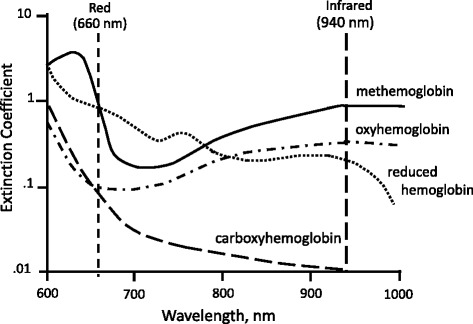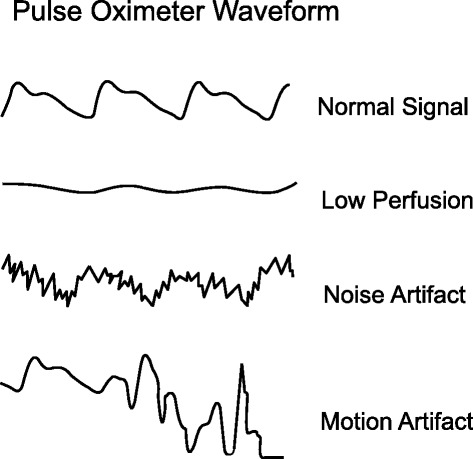Makindo Medical Notes.com |
|
|---|---|
| Download all this content in the Apps now Android App and Apple iPhone/Pad App | |
| MEDICAL DISCLAIMER:The contents are under continuing development and improvements and despite all efforts may contain errors of omission or fact. This is not to be used for the assessment, diagnosis or management of patients. It should not be regarded as medical advice by healthcare workers or laypeople. It is for educational purposes only. Please adhere to your local protocols. Use the BNF for drug information. If you are unwell please seek urgent healthcare advice. If you do not accept this then please do not use the website. Makindo Ltd | |
Pulse oximetry
-
| About | Anaesthetics and Critical Care | Anatomy | Biochemistry | Cardiology | Clinical Cases | CompSci | Crib | Dermatology | Differentials | Drugs | ENT | Electrocardiogram | Embryology | Emergency Medicine | Endocrinology | Ethics | Foundation Doctors | Gastroenterology | General Information | General Practice | Genetics | Geriatric Medicine | Guidelines | Haematology | Hepatology | Immunology | Infectious Diseases | Infographic | Investigations | Lists | Microbiology | Miscellaneous | Nephrology | Neuroanatomy | Neurology | Nutrition | OSCE | Obstetrics Gynaecology | Oncology | Ophthalmology | Oral Medicine and Dentistry | Paediatrics | Palliative | Pathology | Pharmacology | Physiology | Procedures | Psychiatry | Radiology | Respiratory | Resuscitation | Rheumatology | Statistics and Research | Stroke | Surgery | Toxicology | Trauma and Orthopaedics | Twitter | Urology
Related Subjects: Asthma |Acute Severe Asthma |Exacerbation of COPD |Pulmonary Embolism |Cardiogenic Pulmonary Oedema |Pneumothorax |Tension Pneumothorax |Respiratory (Chest) infections Pneumonia |Fat embolism |Hyperventilation Syndrome |ARDS |Respiratory Failure |Diabetic Ketoacidosis
Pulse oximetry can provide an early warning of hypoxemia by working out how much Oxyhaemoglobin there is compared to Deoxyhaemoglobin.
Scientific Concepts
Haemoglobin and Oxygen Transport
Haemoglobin is a protein found in red blood cells that is responsible for transporting oxygen from the lungs to the rest of the body. Haemoglobin can exist in two main states: oxygenated (bound with oxygen, known as oxyhaemoglobin) and deoxygenated (without oxygen, known as deoxyhaemoglobin). The proportion of oxygenated haemoglobin relative to the total haemoglobin in the blood is referred to as oxygen saturation (SpO2).
Spectrophotometry
Spectrophotometry is the technique used in pulse oximetry to measure the light absorption characteristics of haemoglobin. Oxyhaemoglobin and deoxyhaemoglobin absorb light differently at specific wavelengths. Oxyhaemoglobin absorbs more infrared light (around 940 nm), while deoxyhaemoglobin absorbs more red light (around 660 nm).
How Pulse Oximetry Works
- Light Emission and Detection: A pulse oximeter device consists of a light emitter and a photodetector. The emitter sends out two types of light—red and infrared—through a pulsating arterial blood supply, typically in a finger, toe, or earlobe. On the opposite side of the body part, a photodetector captures the light that passes through the tissue.
- Absorption and Calculation: As the light passes through the tissue, some of it is absorbed by the blood. The amount of light absorbed depends on the oxygenation level of the haemoglobin. By comparing the absorption of red and infrared light, the pulse oximeter calculates the ratio of oxyhaemoglobin to total haemoglobin, giving an estimate of the blood's oxygen saturation (SpO2).
- Pulsatile Flow and Signal Processing: The device is designed to measure the light absorption during the pulsatile flow of arterial blood (i.e., during heartbeats) to distinguish it from non-pulsatile components like venous blood, skin, and bone. The pulse oximeter uses algorithms to filter out noise and calculate the oxygen saturation level based on the varying absorption caused by arterial blood flow.
Factors Affecting Accuracy
- Perfusion: Low blood flow (perfusion) to the extremities can affect the accuracy of readings.
- Light Interference: External light sources, such as bright sunlight or fluorescent lights, can interfere with the sensor.
- Skin Pigmentation: Darker skin pigmentation can affect light absorption and slightly alter the readings.
- Nail Polish: Certain nail polishes, especially dark colours, can block the light and interfere with readings.
Clinical Significance
- Pulse oximetry provides critical information about a patient’s oxygenation status, helping healthcare providers detect hypoxemia (low blood oxygen levels) quickly. It is especially useful in situations where oxygenation can rapidly change, such as during anaesthesia, in intensive care, or in patients with respiratory or cardiac conditions.
- While pulse oximetry is an essential tool in clinical settings, it is important to understand its limitations and potential sources of error to ensure accurate interpretation of results.
Common Uses of Pulse Oximetry
- Monitoring oxygen saturation in patients with respiratory or cardiac conditions.
- Assessing oxygen levels during or after surgical procedures that require sedation.
- Determining the effectiveness of supplemental oxygen therapy.
- Checking oxygen levels in patients with conditions that affect breathing, such as asthma, pneumonia, or chronic obstructive pulmonary disease (COPD).
Understanding Pulse Oximetry Readings
- Normal SpO2: A normal pulse oximetry reading typically ranges from 95% to 100%.
- Low SpO2: Level < 90% is low and may indicate hypoxaemia.
- Accuracy: Pulse oximetry readings are generally accurate, but certain factors like poor circulation, skin pigmentation, nail polish, and movement can affect the accuracy.
Limitations of Pulse Oximetry
While pulse oximetry is a useful tool, it does have limitations. It does not measure carbon dioxide levels, and it may not detect certain conditions such as carbon monoxide poisoning. Additionally, the readings can be affected by factors such as cold extremities, hypotension, and the presence of abnormal haemoglobin variants.
| Limitations of pulse oximetry |
|---|
|
|

